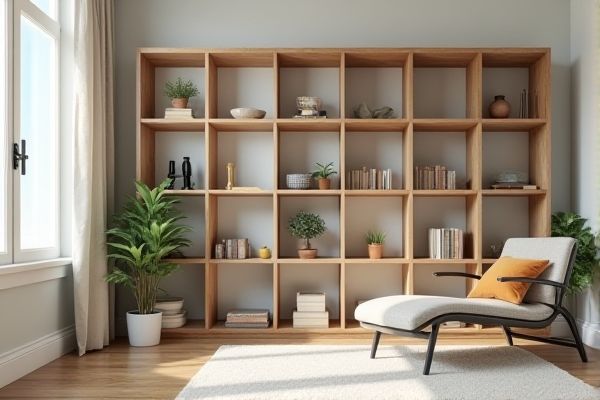
Cube storage offers a versatile and modular solution ideal for organizing items of various sizes, while shelf storage provides open and easily accessible display space perfect for larger or frequently used belongings. Discover how to choose the best option tailored to Your space and organizational needs by reading the rest of the article.
Table of Comparison
| Feature | Cube Storage | Shelf Storage |
|---|---|---|
| Structure | Compartmentalized cubes for individual items | Flat surfaces with open or enclosed shelves |
| Space Utilization | Maximizes vertical and horizontal space efficiently | Less efficient in compact space usage |
| Accessibility | Easy access to specific compartments | Items might overlap; variable accessibility |
| Organization | Ideal for categorizing items by cube | Suitable for grouping by shelf level |
| Visual Appeal | Modern, tidy appearance | Varies from neat to cluttered |
| Flexibility | Fixed cube sizes limit large items | Adjustable shelf heights accommodate various items |
| Common Uses | Books, small decor, office supplies | Books, storage bins, larger objects |
| Cost | Typically moderate to high price | Varies from low to high depending on material |
Introduction to Cube Storage and Shelf Storage
Cube storage utilizes modular compartments or cubbies to organize items efficiently, maximizing vertical and horizontal space. Shelf storage consists of flat, horizontal surfaces supported by frames, ideal for displaying or stacking various objects. Both methods offer customizable solutions but differ in accessibility and space utilization, with cubes providing compartmentalized organization and shelves allowing flexible item placement.
Key Differences Between Cube Storage and Shelf Storage
Cube storage features individual compartments that offer versatile organization for items of varying sizes, while shelf storage consists of open flat surfaces designed for larger or standardized objects. Cube storage enhances customization and compartmentalization, suitable for small to medium items, whereas shelf storage provides easy access and visibility for bulky or heavier items. The structural design of cubes supports diverse storage options, contrasting with shelves that emphasize straightforward, linear placement.
Design and Aesthetic Comparison
Cube storage units offer a minimalist and modular design that blends seamlessly with modern interiors, featuring clean lines and customizable compartments ideal for displaying decorative items or organizing essentials. Shelf storage provides a more traditional and versatile aesthetic, with open or closed shelves that can be tailored to fit various styles, from rustic wood finishes to sleek metal frames. Both options enhance vertical space utilization, but cube storage emphasizes uniformity and Symmetry, while shelf storage allows for more varied and personalized arrangements.
Space Efficiency and Organization
Cube storage maximizes space efficiency by utilizing vertical areas and offering modular compartments tailored for diverse items, allowing for customizable organization. Shelf storage provides easy visibility and access but often results in underutilized vertical space and less flexible container options. Your choice depends on optimizing spatial use versus straightforward item arrangement.
Installation and Assembly Process
Cube storage units typically feature a modular design with individual compartments, allowing for straightforward assembly using basic tools and minimal hardware. Shelf storage often requires wall-mounting or more complex installation, involving precise measurements and securing brackets for stability. Your choice depends on whether you prefer quick setup with flexible arrangement (cube storage) or a fixed, sturdier structure provided by traditional shelves.
Versatility and Customization Options
Cube storage offers exceptional versatility with individual compartments that can be customized using bins, baskets, or drawers to fit various items, making it ideal for personalized organization. Shelf storage provides adjustable or fixed shelves that accommodate larger or oddly shaped objects, supporting a flexible arrangement suited for diverse storage needs. Your choice depends on whether you prioritize modular compartments for detailed sorting or open shelving for broader storage options.
Durability and Material Choices
Cube storage units often feature durable materials such as engineered wood, melamine, or plastic composites designed to withstand everyday wear and resist moisture. Shelf storage typically uses solid wood, metal, or glass, offering increased sturdiness and longevity, especially in heavier-duty applications. Material choice directly influences durability, with cube storage prioritizing lightweight versatility and shelf storage emphasizing structural strength and resilience.
Cost Analysis: Cube Storage vs Shelf Storage
Cube storage typically offers a more cost-effective solution due to its modular design, which maximizes vertical space and reduces the need for additional shelving units. Shelf storage, while often less expensive upfront, can incur higher long-term costs related to inefficient space use and maintenance. Businesses seeking optimized storage expenses should weigh initial investment against durability and space efficiency, with cube storage providing better value in dense, flexible environments.
Best Use Cases for Each Storage Type
Cube storage excels in organizing smaller items, such as toys, office supplies, and craft materials, by providing individual compartments that enhance accessibility and visibility. Shelf storage is ideal for larger, bulkier items like books, appliances, and decorative pieces, offering an open design that maximizes vertical space and supports heavy weights. Selecting between cube and shelf storage depends on item size, frequency of access, and desired room aesthetics.
Conclusion: Choosing the Right Storage Solution
Cube storage offers modular flexibility and easy access to items, making it ideal for personalized and small-space organization. Shelf storage maximizes vertical space and supports heavier or bulkier items, best suited for large collections or heavy-duty needs. Selecting the right storage solution depends on the type of items stored, space constraints, and desired accessibility to optimize organization efficiency.
 homyna.com
homyna.com